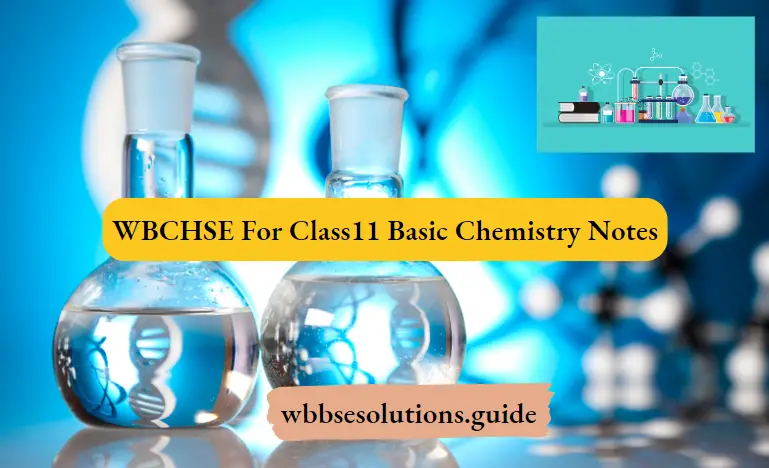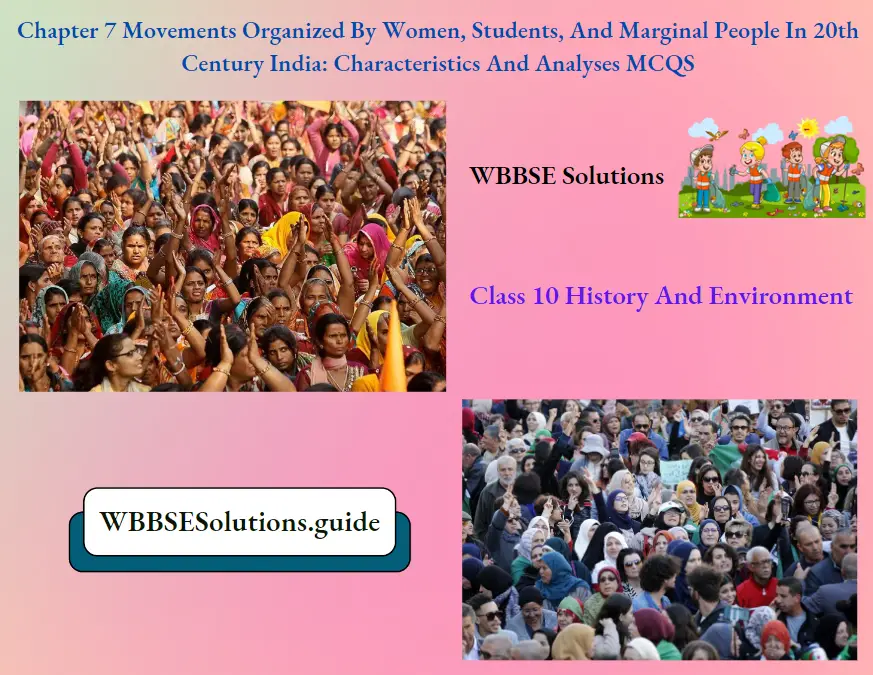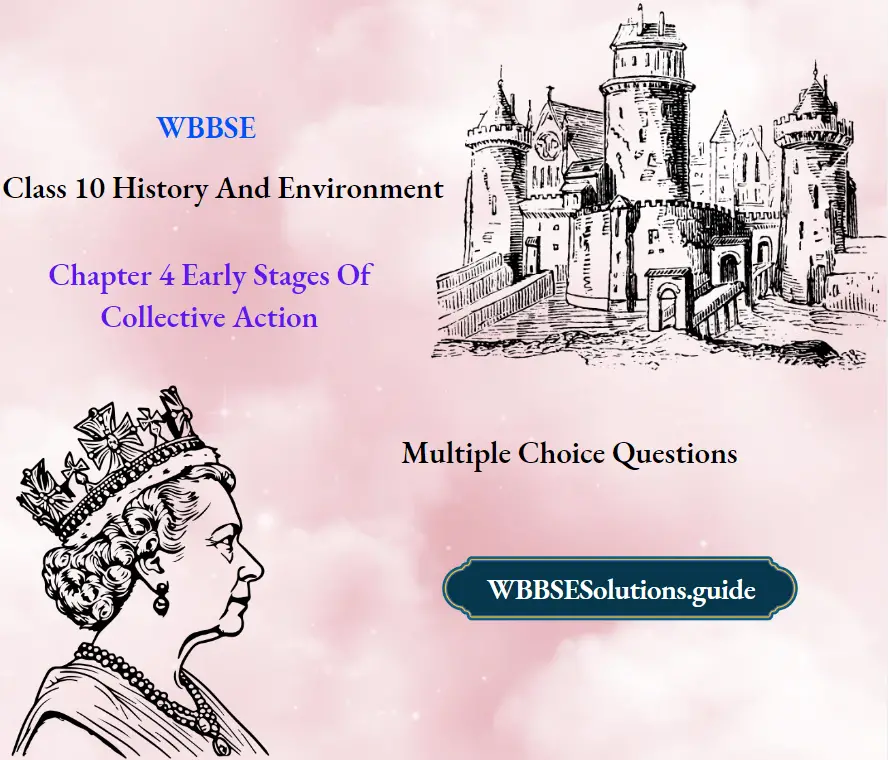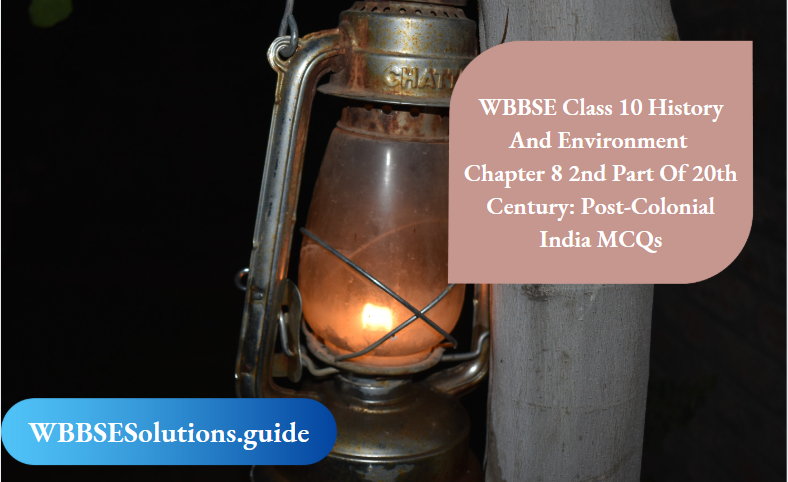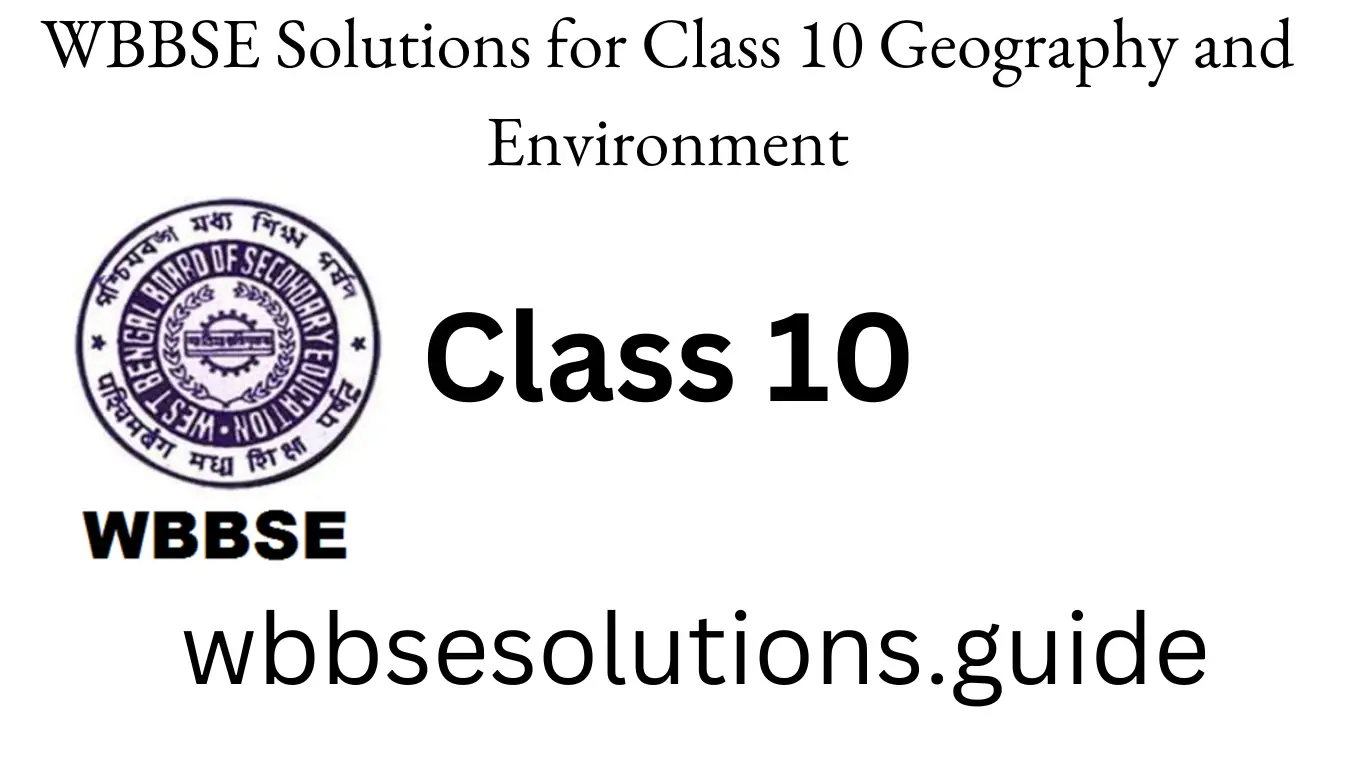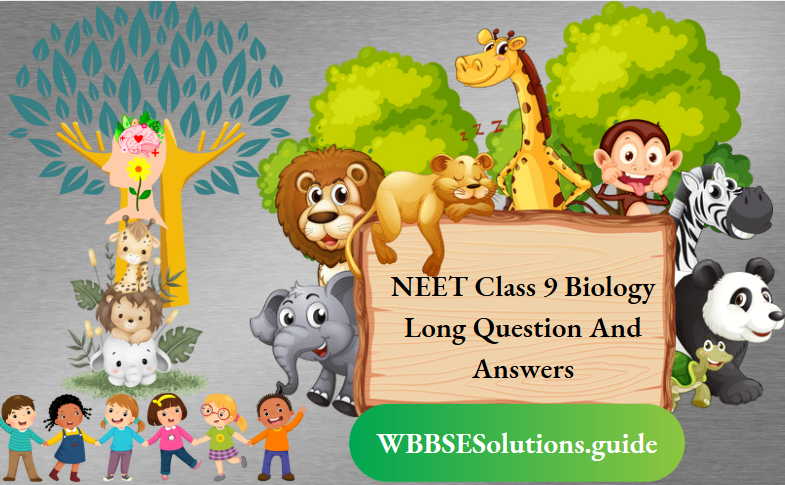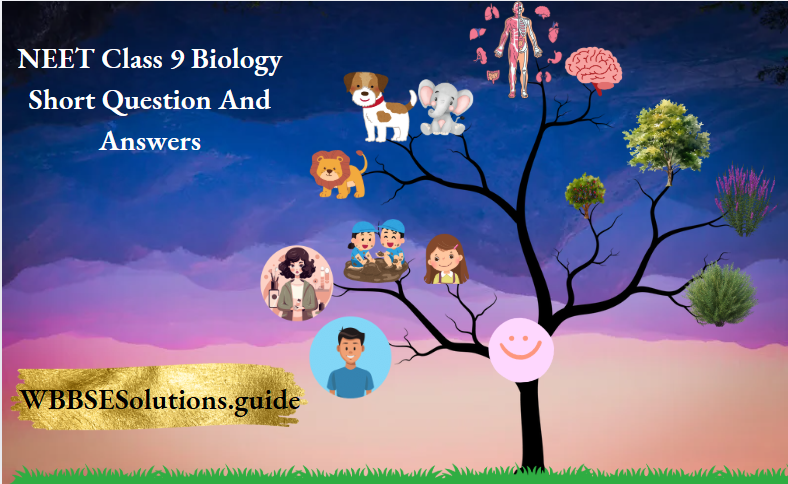Chapter 1 Control And Co-Ordination In Living Organisms MCQs
Question 1. When the intensity of the stimulus is the cause of movement, it is termed as_________________
- Tropism
- Tactism
- Nastism
- None of the above
Answer. (3) Nastism
Question 2. Earthworm moves with the help of_______________
- Setae
- Pseudopodia
- Tube feet
- Cilia
Answer. (1) Setae
Question 3. Balancing organ of fish are_______________
- Lateral line
- Swim bladder
- Gills
- Fins
Answer. (2) Swim bladder
Read and Learn More Class 10 Life Science MCQs
Question 4. The locomotory organ of amoeba are______________
- Setae
- Pseudopodia
- Tube feet
- Cilia
Answer. (2) Pseudopodia
Question 5. Tactic movement is found in________________
- Chlamydomonas
- Earthworm
- Cockroach
- Fish
Answer. (1) Chlamydomonas
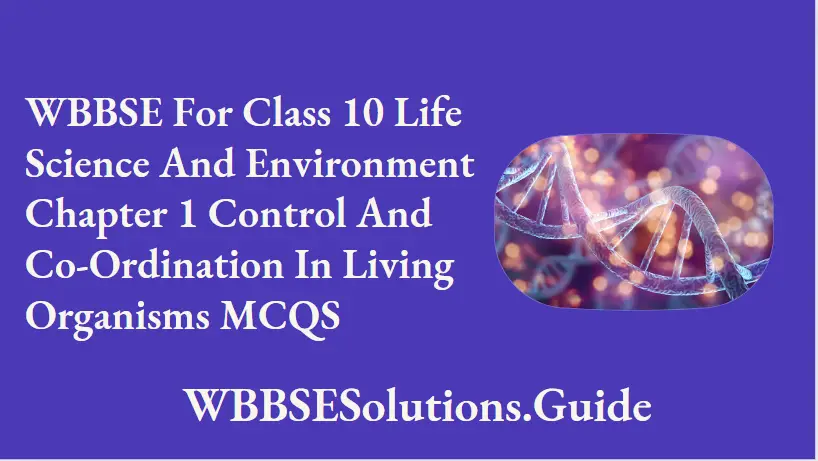
Question 6. of stimulus is the cause of tropic movement.
- Intensity
- Source
- Direction
- None of the above
Answer. (c) Direction
Question 7. Locomotion in plants is termed as_________________
- Tropism
- Tactism
- Nastism
- None of the above
Answer. (2) Tactism
Question 8. What is the other name of thigmotropism?
- Phototropism
- Heliotropism
- Hydrotropism
- Haptotropism
Answer. (4) Hapto tropism
Question 9. Number of joints in our body are________________
- Twenty four
- Twenty three
- Twenty one
- Twenty two
Answer. (4) Twenty two
Question 10. Movable joints allow
- Free movement in various directions
- No movement
- A limited degree of movement
- None of the above
Answer. (1) Free movement in various directions
Question 11. Ball and socket joint is__________________
- Slightly movable joint
- Immovable joint
- Movable joint
- None of the above
Answer. (3) Movable joint
Question 12. Pivot joint allows
- Rotation only
- Movement in one direction only
- The sliding of bones
- Limited degree of movement
Answer. (1) Rotation only
Question 13. The movement of an organ in response to the stimulus of moisture is known as:
- Geotropism
- Phototropism
- Hydrotropism
- Haptotropism
Answer. (4) Hydrotropism
Question 14. The orientation of stems and roots in response to the force of gravity is called:
- Chemotropism
- Geotropism
- Hydrotropism
- Thigmotropism
Answer. (2) Geotropism
Question 15. The locomotory organs of hydra are :
- Setae
- Cilia
- Flagella
- Basal disc, foot & tentacles
Answer. (4) Basal disc, foot & tentacles
Question 16. Schwann cell is related to which of the following?
- Dendrite
- Axo
- Cell body
- Synapse
Answer. (2) Axon
Question 17. “Titillation brings about the contraction of the foot” – What kind of reflex action is it?
- Habitual reflex action
- Congenital superficial reflex action
- Complex reflex action
- Congenital deep reflex action.
Answer. (2) Congenital superficial reflex action
Question 18. Which of the following is not present in a neuron?
- Schawann cell
- Plastid
- Nissl’s granule
- Node of Ranvier.
Answer. (2) Plastid
Question 19. Which of the following co-ordinates the balance of the body during locomotion?
- Cerebrum
- Cerebellum
- Pons
- Medulla oblongata.
Answer. (2) Cerebellum
Question 20. The optic nerve is a _________
- Motor nerve
- Spinal nerve
- Mixed nerve
- Sensory nerve
Answer. (4) Sensory nerve.
Question 21. How many pairs of cranial nerves are present in the human body?
- 10
- 12
- 14
- None of these.
Answer. (2) 12
Question 22. Two hemispheres of cerebrum remain connected by_________________
- Corpus striatum
- Corpus luteum
- Corpus callosum
- Medulla.
Answer. (3) Corpus callosum
Question 23. The olfactory nerve helps in the sensation of___________.
- Vision
- Smell
- Hearing
- Taste.
Answer. (2) Smell
Question 24. The protective covering of the brain is____________.
- Pericardium
- Conjuctiva
- Pleura
- Meninges.
Answer. (4) Meninges.
Question 25. Which one is not a component of the Complex Reflex arc?
- Afferent neurone
- Efferent neurone
- Intermediate neurone
- Afferent nerve.
Answer. (4) Afferent nerve.
Question 26. Which one of the following is associated with the nasal body?
- Cell body
- Axon
- Schwann cell
- Neurilemma.
Answer. (1) Cell body
Question 27. The number of spinal nerves in man is_______________.
- 10 pairs
- 12 pairs
- 31 pairs
- 33 pairs
Answer. (3) 31 pairs
Question 28. The main component of the central nervous system is____________.
- Brain
- Spinal cord
- Both Brain and Spinal cord
- None of them.
Answer. (3) Both Brain and Spinal cord
Question 29. Which part of the brain performs thermoregulation?
- Cerebrum
- Cerebellum
- Hypothalamus
- Pons
Answer. (3) Hypothalamus
Question 30. The region of the human brain that regulates “body balance” is___________
- Cerebrum
- Cerebellum
- Thalamus
- Hypothalamus
Answer. (2) Cerebellum
Question 31. In the eye of which animal pecten is found?
- Fish
- Tiger
- Pigeon
- Toad
Answer. (3) Pigeon
Question 32. The area of the eye for best vision is ___________
- Blindspot
- Yellow spot
- Optic disc
- Cornea.
Answer. (2) Yellow spot
Question 33. The point where the retina and the optic nerve meet is called.
- Yellow spot
- Optic centre
- Blindspot
- Eye spot
Answer. (3) Blindspot
Question 34. Hypermetropia is corrected by __________
- Convex lens
- Concave lens
- Cylindrical lens
- Photochromatic lens
Answer. (1) Convex lens
Question 35. The shape of lens present in human eye is____________
- Concave
- Convex
- Biconvex
- Biconcave
Answer. (d) Biconvex.
Question 36. The part of the human eyeball that is photosensitive is__________
- Choroid
- Sclera
- Cornea
- Retina.
Answer. (4) Retina.
Question 37. The oval window is found in_______________
- Ear
- Heart
- Brain
- Eye
Answer. (2) Ear
Question 38. Rhodopsin is the pigment of_______________
- Rod cells
- Cone cells
- Epithelial cells
- Olfactory cells.
Answer. (1) Rod cells
Question 39. Where is the sclera located?
- Tongue
- Skin
- Eye
- Ear
Answer. (3) Eye
Question 40. The part of the human eye that functions as a refraction medium is___________
- Cornea
- Retina
- Vitreous humor
- Choroid.
Answer. (3) Vitreous humor
Question 41. What is Auxin?
- Animal Hormone
- Enzyme
- Plant Hormone
- Excretory Product
Answer. (3) Plant Hormone
Question 42. Which one of the following is a hormone?
- Pepsin
- Reserpine
- Ethylene
- Cytosine.
Answer. (3) Ethylene
Question 43. What is Gibberelline?
- Animal hormone
- Enzyme
- Plant hormone
- Excretory product
Answer. (3) Plant hormone
Question 44. The hormone which is not a phytohormone is____________
- STH
- IAA
- GA.
- None of the above
Answer. (1) STH
Question 45. The type of movement of plants influenced by auxin is____________
- Nyctinasty
- Photonasty
- Phototropism
- Hydrotropism
Answer. (3) Phototropism
Question 46. Hormones are also called_________
- Enzymes
- Receptor
- Physical co-ordinators
- Chemical co-ordinators
Answer. (4) chemical co-ordinators
Question 47. An artificial hormone is __________________
- Indole acetic acid
- Naphthalene acetic acid
- Gibberellic acid
- Ziatin
Answer. (2) Naphthalene acetic acid
Question 48. Insulin is secreted from___________.
- Anterior part of Pituitary gland
- Thyroid gland
- Kidney
- Pancreas
Answer. (4) Pancreas
Question 49. Which of the following glands is a mixed gland?
- Thyroid
- Pituitary
- Pancreas
- Liver.
Answer. (3) Pancreas
Question 50. Which one of the following is not an endocrine gland?
- Salivary gland
- Adrenal gland
- Thyroid gland
- Pituitary gland.
Answer. (1) Salivary gland
Question 51. From which of the following endocrine glands is ACTH secreted?
- Adrenal gland
- Thyroid gland
- Islets of Langerhans in pancreas
- Pituitary gland.
Answer. (4) Pituitary gland.
Question 52. Which one of the following is an endocrine gland?
- Salivary gland
- Liver
- Tear gland
- Thyroid gland.
Answer. (4) Thyroid gland.
Question 53. From which of the following glands is Insulin secreted?
- Thyroid gland
- Pituitary gland
- Islets of langerhans
- Adrenal gland.
Answer. (3) Islets of langerhans
Question 54. Disease caused by deficiency of Thyroxine is________________
- Anaemia
- Cretinism
- Diabetes
- Polyurea.
Answer. (2) Cretinism
Question 55. Which one is an emergency hormone?
- STH
- Thyroxine
- Adrenaline
- Insulin.
Answer. (3) Adrenaline
Question 56. In the absence of which of the following there is an increase in blood sugar level?
- Thyroxine
- Insulin
- Glucagon
- Adrenaline.
Answer. (2) Insulin
Question 57. From which of the following glands is thyroxine secreted?
- Thyroid gland
- Pituitary gland
- Adrenal gland
- Islets of langerhans.
Answer. (1) Thyroid gland
Question 58. Iodine is the essential component for the hormone____________
- Insulin
- Glucagon
- Adrenaline
- Thyroxine.
Answer. (4) Thyroxine.
Question 59. From which of the following endocrine glands is a somatotrophic hormone secreted?
- Adrenal gland
- Pancreas
- Pituitary gland
- Thyroid gland.
Answer. (3) Pituitary gland
Question 60. Which of the following hormones is secreted from the pituitary gland?
- Thyroxine
- Insulin
- Adrenaline
- STH
Answer. (4) STH
Question 61. The hormone Testosterone is secreted from____________
- Testis
- Ovary
- Adrenal gland
- Thyroid gland.
Answer. (1) Testis
Question 62. Which one is a mixed type among the following glands?
- Thyroid
- Pituitary
- Pancreas
- Adrenal
Answer. (3) Pancreas
Question 63. The name of a hormone secreted from the ovary is______________.
- Oestrogen
- Testosterone
- GTH
- ACTH
Answer. (1) Oestrogen
Question 64. Which one is not an endocrine gland?
- Salivary gland
- Pituitary gland
- Thyroid gland
- Adrenal gland.
Answer. (1) Salivary gland
Question 65 The endocrine glands do not secrete____________.
- Insulin
- Thyroxine
- Pepsin
- Adrenalin
Answer. (3) Pepsin
Question 66. Which of the following hormones control physical, mental, and sexual growth in man?
- S.T.H
- GT.H
- T.S.H.
- Thyroxine
Answer. (4) Thyroxine
Question 67. Emergency hormone is secreted from________
- Pituitary
- Thyroid
- Adrenal
- Pancreas gland.
Answer. (3) Adrenal.
Question 68. Hypofunctioning of S.T.H. leads to_______
- Dwarfism
- Cretinism
- Goitre
- Diabetes mellitus.
Answer. (1) dwarfism.
Question 69. Which one of the following hormones participates in the metamorphosis of a toad?
- Auxin
- GT.H
- Adrenalin
- Thyroxine.
Answer. (4) Thyroxine.
Question 70. Which one of the following hormones is secreted from the ovary?
- Insulin
- Testosterone
- Oestrogen
- GTH
Answer. (4) Oestrogen
Question 71. Which one is not an endocrine gland?
- Salivary gland
- Pituitary gland
- Thyroid gland
- Adrenal gland
Answer. (1) Salivary gland
Question 72. Deficiency of which hormone causes Diabetes mellitus?
- Thyroxin
- Insulin
- Adrenalin
- STH.
Answer. (2) Insulin
Question 73. Which of the following endocrine glands secrete thyroxine?
- Thyroid
- Testes
- Adrenal
- Pituitary
Answer. (1) Thyroid
Question 74. Who discovered the sensitivity of plants?
- Parlor
- J.C. Bose
- Darwin
- Went
Answer. (2) J.C. Bose
Question 75. Which type of movement shows in Volvox?
- Phototropic
- Thermotropic
- Phototactic
- Gsotropic
Answer. (3) Phototactic
Question 76. Chemonastic movement is found in___________
- Drosera
- Sunflower
- Oxalis
- Mimosa Pudica
Answer. (1) Drosera
Question 77. Seed germination is induced by which hormone?
- Gibberellic acid
- Auxin
- Cytokinin
- ABA
Answer. (1) Gibberellic acid
Question 78. Which hormone delays leaf senescence?
- Auxin
- Gibberellin
- Cytokinin
- IAA
Answer. (4) Cytokinin
Question 79. The surface area of wings is increased in birds with the help of_____________.
- Pectoralis major
- Pectoralis minor
- Remiges
- Rectrices
Answer. (3) Remiges
Question 80. Triceps helps in______.
- Flexion
- Abduction
- Adduction
- Extension
Answer. (4) Extension
Question 81. Klinostat demonstrates____________.
- Geotropism
- Hydrotropism
- Thigmotropism
- Phoxotropism
Answer. (1) Geotropism
Question 82. Avena coleoptile test is for___________.
- Auxin
- Gibberellin
- Cytokinin
- Ethylene
Answer. (1) Auxin
Question 83. Stress is reduced by____________
- ADH
- Adrenaline
- Renin
- STH
Answer. (2) Adrenaline
Question 84. TRH is produced from_____________.
- Hypothalamus
- Adrenal
- Pituitary
- Thyroid
Answer. (1) Hypothalamus
Question 85. Milk releasing hormone is_____________.
- Oxytocin
- Vasopresin
- TnRH
- TSH
Answer. (1) Oxytocin
Question 86. The following is a motor nerve_________________
- Facial
- Oculomotor
- Optic
- Trigeminal
Answer. (2) Oculomotor
Question 87. The part of the brain that joins it with the spinal cord is_____________.
- Medulla
- Pons
- Hypothalamus
- Cerebellum
Answer. (1) Medulla
Question 88. Synovial joints are______________
- Immovable
- Freely movable
- Slightly movable
- Fixed
Answer. (2) Freely movable
Question 89. Retrices in bird are located in___________
- Tail feather
- Wing
- Sternum
- Legs
Answer. (1) Tail feather
Question 90. The Semicircular canals are located in______
- Eye
- Ear
- Nose
- Tongue
Answer. (2) Ear
Question 91. Adduction and abduction is a common phenomenon found in____________
- Leg
- Arm
- Shoulder
- Both arm and shoulder
Answer. (4) Both arm and shoulder
Question 92. Stimulus is______________________
- A physical force
- Energy
- Changed environment
- None of these
Answer. (2) Energy
Question 93. Irritability is________________
- Respond to stimulus
- Non-respond to stimulus
- Changes within body
- None of these
Answer. (1) Respond to stimulus
Question 94. FSH is secreted from_______________
- Thyroid gland
- Adrenal gland
- Pituitary gland
- Graafian follicles
Answer. (4) Graafian follicles
Question 95. Who is called the father of endocrinology?
- E.H. Starling
- Thomas Addison
- Huxley
- Peterson
Answer. (2) Thomas Addison
Question 96. The gland having both exocrine am3 endocrine functions is____________
- Thyroid
- Gastric
- Pancreas
- Pituitary
Answer. (3) Pancreas
Question 97. Another name for antidiuretic hormone is ____________
- Oxytocin
- Prolactin
- Vasopressin
- None of these
Answer. (3) Vasopressin
Question 98. Which one of the following is not an endocrine gland?
- Thyroid
- Pituitary
- Adrenal
- Parotid
Answer. (4) Parotid
Question 99. Gigantism is due to over-secretion of which one of the following?
- LH
- GH
- TSH
- ADH ‘
Answer. (4) GH (Growth Hormone)
Question 100. The anterior lobe of Pituitary is also called _____________
- Pars nervosa
- Pars distalis
- Pars intermedia
- None of these
Answer. (2) Pars distalis
Question 101. The reabsorption of water by kidney tubules is stimulated by_______________
- Oxytocin
- Androgen
- Protection
- Vasopressin
Answer. (4) Vasopressin
Question 102. The smallest endocrine gland is______________
- Thyroid
- Parathyroid
- Adrenal
- Pituitary gland
Answer. (4) Pituitary gland
Question 103. The largest endocrine gland in adult is___________
- Thyroid gland
- Pituitary
- Adrenal
- Ovary
Answer. (1) Thyroid gland
Question 104. The secretion of endocrine gland is directly released in________________
- Blood
- Gut
- Lymph
- Ducts
Answer. (1) Blood
Question 105. The pituitary gland in mammals is made up of____________
- Two parts
- Three parts
- Six parts
- One part only
Answer. (2) Three parts
Question 106. Which one of the following is not an endocrine disease?
- Goitre
- Pneumonia
- Cretenism
- Dwarfism
Answer. (2) Pneumonia
Question 107. Deficiency of thyroid hormone causes ________________
- Exophthalmic goitre
- Acromegaly
- Myxoedema
- All of three
Answer. (3) Myxoedema
Question 108. The hormone that regulates basal metabolism in the body is secreted from_____________
- Pituitary
- Thyroid gland
- Pancreas
- Parathyroid
Answer. (2) Thyroid gland
Question 109. The function of the thymus gland is _____________
- Immunity
- Growth
- Formation of RBC
- Fight or flight
Answer. (1) Immunity
Question 110. Kidney stones may be caused by hypersecretion of the ________________
- Thyroid gland
- Parathyroid gland
- Thymus
- Pancreas
Answer. (2) Parathyroid gland
Question 111. Hormones are destroyed mainly in______________
- Liver
- Heart
- Stomach
- Intestine
Answer. (1) Liver
Question 112. The glucagon hormone in pancreas is secreted by________________
- Gamma cells
- Alpha cells
- Delta cells
- Beta cells
Answer. (2) Alpha cells
Question 113. Which of the following has a higher level in summer and a lower level in winter?
- Thyroxine
- Insulin
- Glucagon
- Vasopressin
Answer. (4) Vasopressin
Question 114. Which of the following induces parturition?
- Vasopressin
- Oxytocin
- GH
- TSH
Answer. (2) Oxytocin
Question 115. Islets of langerhans are found in _________________
- Anterior pituitary
- Kidney Cortex
- Spleen
- Endocrine pancreas
Answer. (4) Endocrine pancreas
Question 116. The hormone responsible for fight and flight response is______________
- Adrenalin
- Thyroxine
- ADH
- Oxytocin
Answer. (1) Adrenalin
Question 117. Which gastrointestinal hormone stimulates insulin secretion?
- Gastrin
- CCK
- Secretion
- GIP
Answer. (4) GIP
Question 118. During an emergency, which of the following hormones is secreted?
- Aldosterone
- Thyroxine
- Adrenalin
- Calcitonin
Answer. (3) Adrenalin
Question 119. When the animal is aggressive and attacks, the hormone responsible for it is_________________
- Thyroxin
- Testosterone
- Oxytocin
- Adrenalin
Answer. (d) Adrenalin
Question 120. The hormone produced in allergic reaction is _____________
- Gluco corticoides
- Mineralo corticoides
- Nor epinephrine
- Epinephrine
Answer. (1) Gluco corticoids
Question 121. Which is the gastrointestinal hormone?
- Prolactin
- Enterokinase
- Nor – epinephrin
- Secretin
Answer. (4) Secretin
Question 122. In plants, auxin synthesis occurs in _________________
- Cortex
- Xylem cells
- Phloem cells
- Root and shoot tips
Answer. (4) Root and shoot tips
Question 123. A substance that induces dormancy of seed is _____________
- ABA
- GA
- Urea
- Cytokenin
Answer. (1) ABA
Question 124. Cytokinin can cause _____________
- Early senescence in leaves
- Delay in leaf senescence
- Elongation of internodes
- Parthenocarpy
Answer. (2) Delay in leaf senescence
Question 125. Promoting cell division in plants is the characteristic of___________
- Abscisic acid
- Ethylene
- IAA
- Cytokinin
Answer. (4) Cytokinin
Question 126. The term cytokinin was introduced by________________
- Miller and Skoog
- Letham
- Steward
- None of these
Answer. (4) None of these
Question 127. Auxin were first isolated from the plants by______________
- Went
- Boysen – Jensen
- Darwin
- Sachs
Answer. (1) Went
Question 128. Gibberellins in pure crystallin a form were first isolated_____________
- By Kurosawa
- From rice plants in Japan
- By Yabuta and Sumiki
- Both 2 and 3
Answer. (3) By Yabuta and Sumiki
Question 129. The formation of pseudopodia results in ___________________
- Ciliary movement
- Amoeboid movement
- Flagellar movement
- Muscular movement
Answer. (2) Amoeboid movement
Question 130. The function of synovial fluid is___________
- Avoid friction
- Lubrication
- Nourishment
- All of these
Answer. (4) All of these
Question 131. The connective tissue joining muscle to bone is________________
- Ligament
- Tendons
- Synovial fluid
- None of these
Answer. (2) Tendons
Question 132. Animals which can not exhibit locomotion are___________
- Corals
- Sponges
- Amoeba
- Both (1) and (2)
Answer. (4) Both (1) and (2)
Question 133. plant can exhibit locomotion_______________
- Chlamydomonas
- Spirogyra
- Volvox
- Both (1) and (3)
Answer. (4) Both (1) and (3)
Question 134. Earthworm shows locomotion by______
- Scales
- Muscles
- Setae and muscles
- Pseudopodia
Answer. (3) Setae and muscles
Question 135. Which one shows bipedal locomotion?
- Toad
- Cockroach
- Man
- Lizard
Answer. (3) Man
Question 136. The streaming movement of protoplasm within a cell is ________________
- Diffusion
- Osmosis
- Cyclosis
- All
Answer. (3) Cyclosis
Question 137. Fin which helps the fish to steer the direction is______________
- Pectoral fin
- Pelvic fin
- Caudal fin
- Dorsal fin
Answer. (3) Caudal fin
Question 138. The type of movement in Mimosa pudica is _____________
- Nyctinasty
- Photonasty
- Seismonasty
- Chemonasty
Answer. (3) Seismonasty
Question 139. The tropic movement in plants is controlled by________________
- Gibberellins
- Auxin
- Cytokinin
- Ethylene
Answer. (2) Auxin
Question 140. The other name of sleeping movement in plants is____________
- Thermonasty
- Nyctinasty
- Chemonasty
- All
Answer. (2) Nyctinasty
Question 141. ‘V-shaped muscle in fishes is known as _____________
- Swim bladder
- Pectoral fin
- Myotome muscle
- None
Answer. (3) Myotome muscle
Question 142. Muscle present at the anterior side of upper arm is________________
- Triceps muscle
- Flexor muscle
- Biceps muscle
- All of these
Answer. (3) Biceps muscle
Question 143. Connective tissue joining bone to bone is___________________
- Tendon
- Ligament
- Cartilage
- None
Answer. (2) Ligament
Question 144. Movement of locomotion in plants induced by external stimulus is _____________
- Tactic movement
- Tropic movement
- Nastic movement
- Cyclosis
Answer. (1) Tactic movement
Question 145. The seismonastic movement is found in plants_____________
- Touch me not plant
- Mimosa pudica
- Lajwanti
- All of these
Answer. (4) All of these
Question 146. Centre of thirst and hunger is_________________
- Medulla oblongata
- Cerebellum
- Cerebrum
- Hypothalamus
Answer. (4) Hypothalamus
Question 147. Corpus callosum is seen in the________
- Pituitary
- Ovary
- Brain
- Thyroid
Answer. (3) Brain
Question 148. Cavities of the brain are called _____________
- Auricles
- Coelom
- Lumen
- Ventricles
Answer. (4) Ventricles
Question 149. In reflex action, the term ‘executive’ refers to_________
- Sensory neuron
- Motor neuron
- Association neuron
- Dorsal root ganglion
Answer. (2) Motor neuron
Question 150. A serious injury to medulla will cause_____________
- Death
- Paralysis
- Stroke
- None of these
Answer. (1) Death
Question 151. The average weight of the human brain is _________
- 1000 gms
- 1200 gms
- 1350 gms
- 1500 gms
Answer. (3) 1350 gms
Question 152. Point out which one is not a reflex action.
- Sneezing
- Yawning
- Coughing
- Weeping
Answer. (4) Weeping
Question 153. Conditioned reflex is related to_____________
- Sanger
- Haeckel
- Pavlov
- Flemming
Answer. (3) Pavlov
Question 154. Micturition Centre is_____________
- Medulla
- Cerebrum
- Cerebellum
- Pons
Answer. (2) Cerebrum
Question 155. In vertebrate neurotransmitter is_____________
- Acetylcholine
- Sympathein
- Both (1) and (2)
- None
Answer. (3) Both (1) and (2)
Question 156. Acetylcholine is________
- Toxin
- Chemical transmitter
- Vitamin
- Enzyme
Answer. (2) Chemical transmitter
Question 157. The antiseptic property of tears is due to_________
- Nasozyme
- Septizyme
- Lysozyme
- All the three
Answer. (3) Lysozyme
Question 158. Fovea Centralis is also known as___________
- Red spot
- Yellow spot
- Green spot
- White spot
Answer. (2) Yellow spot
Question 159. The point on the retina where most clear image is formed is______________
- Area central
- Blindspot
- Fovea centralis
- Ora service
Answer. (3) Fovea centralis
Question 160. The vitreous humour :
- Keeps the lens in position
- Supports retina
- Act as refractory medium
- All the three
Answer. (4) All the three
Question 161. The pigments found in the cone are _________
- Iodopsin
- Rhodopsin
- Erythrobabe
- None of these
Answer. (1) Iodopsin
Question 162. The organ of corti is found in____________
- Internal ear
- External ear
- Eye
- Skin
Answer. (1) Internal ear
Question 163. The maculae are located in ____________
- Utriculus
- Sacculus
- Both (1) and (2)
- Neither 1 nor 2
Answer. (3) Both (1) and (2)
Question 164. The number of ear ossicles in man is______________
- 1
- 2
- 3
- 4
Answer. (3) 3
Question 165. Alzheimer disease is characterised by______________
- Dementia
- Degeneration of brain
- Degeneration of vertebrae
- Both (1) and (2)
Answer. (d) Both (a) and (b)
Question 166. Sense of smell is perceived by________________
- Pituitary
- Hypothalamus
- Olfactory lobe
- Cerebrum
Answer. (3) Olfactory lobe
Question 167. Which one of the following does not act as a Neurotransmitter?
- Cortisone
- Acetylcholine
- Epinephrine
- Norepinephrine
Answer. (1) Cortisone
Life Science Class 10 West Bengal Board Chapter 1 Control And Co-Ordination In Living Organisms Fill In The Blanks
Question 1. Chemotropism is affected by___________substances.
Answer. Chemical
Question 2. Root is__________phototropic.
Answer. Negatively.
Question 3. During flight the tail of a bird works like a__________and at the time of sitting it acts as a__________organ.
Answer. Propeller, balancing.
Read and Learn More About WBBSE Solutions for Class 10 Life Science And Environment
Question 4. Locomotion by tail is found in_________cell and______
Answer. Sperm, fish.
Question 5. Prawn swims in water by___________
Answer. Swimming legs.
Question 6. Flagella helps in the movement of___________
Answer. Euglena.
Question 7. The__________is geotropic and the stem is__________
Answer. Root, phototropic.
You can download the class 10 WBBSS Life Science book pdf from wbbsesolutions.guide
Question 8. Somersault locomotion is found in__________
Answer. Hydra.
Question 9. In_____lower leaflets of the trifoliate leaf alternately move up and down due to changes in____________
Answer. Telegraph plant, turgor pressure
Question 10. The three-layered membranous covering of the human brain is collectively called___________
Answer. Meninges
Question 11. In plants nervous system is__________
Answer. Absent
Question 12. The tear gland is the secretory center of__________in eye.
Answer. Tear
Question 13. The place where optic nerve enters into the retina is___________
Answer. Blind spot
Question 14. The central nervous system consists of____________and spinal cord.
Answer. Brain
Question 15. Eye is called a___________ organ.
Answer. Sense of photo-receptor.
Question 16. Macula lutea is same as__________or_______ while scala media is the other name of___________
Answer. Yellow spot, fovea, the middle part of the cochlea.
Question 17.____________ is a gaseous animal hormone.
Answer. Pheromone
Question 18. Dwarfism is the cause of_____________failure.
Answer. Pituitary
Question 19. __________regulates the cell division in plants.
Answer. Kinin
Question 20. Direct action of the thyroid hormone is on the__________
Answer. Growth
Question 21. Islets of langerhans secrete______ and___________ hormones.
Answer. Glucagon, Insulin
Question 22. Pineal gland secretes__________
Ans. Melatonin
Question 23.___________ is a gaseous plant hormone.
Answer. Ethylene
Question 24.__________ hormone is responsible for fertilization.
Answer. Fertilizin
Question 25.___________ is a emergency hormone and is secreted from______
Answer. Adrenaline, Adrenal gland.
Question 26.__________ is a wound hormone of the plants.
Answer. Traumatic.
Question 27. The three-layered membranous covering of the human brain is collectively called ‘___________ ‘
Answer. Meninges.
Question 28. ___________of neuron conduct impulse from the previous neuron to the cell body.
Answer. Dendrite.
Question 29. The cavities inside the central nervous system are filled with a fluid called___________
Answer. Cerebro Spinal Fluid.
Question 30. The cerebrum is the_________part of the brain.
Answer. Largest
Question 31. The structural and functional unit of the nervous system is called______
Answer. Neuron.
Question 32. The part of the brain related to balancing is called___________
Answer. Cerebellum.
Question 33. The meeting place of two neurones is called__________
Answer. Synapse.
Question 34. The action that is controlled by the spinal cord is called_____action.
Answer. Reflex.
Question 35. The eyeball has____________layers of covering.
Answer. three.
Question 36. With the use of _______________lens, myopia can be corrected.
Answer. Concave.
Question 37. Rod and cone cells are located in___________
Answer. Retina.
Question 38. The semicircular canal is present in ___________
Answer. Internal ear.
Question 39.____________ plays an active role in cell division.
Answer. Auxin.
Question 40.______________ helps in seed germination by removing dormancy of seeds.
Answer. Gibberellin.
Question 41. Tropic movement is controlled by____________
Answer. Auxin.
Question 42. Three natural plant hormones are Auxin, Gibberellins and__________
Answer. Cytokinin.
Question 43. _________is the group name of plant hormones.
Answer. Phytohormone.
Question 44. Cytokinin stimulates mitotic cell division in the__________tissue.
Answer. Meristematic.
Question 45. Auxin hormone promotes__________ dominance in plant.
Answer. Apical.
Question 46.___________ hormone helps in the control of weeds.
Answer. Auxin.
Question 47.___________ retards senscence in plants.
Answer. Cytokinin.
Question 48. Due to deficiency of_______hormone Diabetes mellitus takes place in our body.
Answer. Insulin.
Question 49. Hyperfunctioning of STH causes______ in humans.
Answer. Acromegaly.
Question 50. The chemical messenger in an animal body is_______
Answer. Hormone.
Question 51. The hormonal system and nervous system are similar because both are systems of________
Answer. Co-ordination.
Question 52.________ is secreted by_________ cells of Islets of langerhans.
Answer. Insulin, Beta
Question 53. Chemical co-ordination is controlled by___________
Answer. Hormone.
Question 54. TSH stands for___________
Answer. Thyroid Stimulating Hormone.
Question 55. _____________is a mixed gland.
Answer. Pancreas.
Question 56. Hormones are present both in_______and__________
Answer. plant, animal.
Question 57. Hormones are secreted ___________from
Ans. Endocrine.
Question 58. Cretinism is caused by less secretion of__________
Answer. Thyroxine.
Question 59. The name of the hormone that is secreted from the anterior pituitary gland that regulates thyroxine secretion is known as____________
Answer. Thyroid Stimulating Hormone.
Question 60. The leader of endocrine orchestra is____________
Answer. Pituitary.
Question 61. The hormone that is secreted from the anterior pituitary and regulates the secretion of adrenal cortical hormone is__________
Answer. ACTH.
Question 62. The hormone secreted from the anterior pituitary gland which regulates the secretion of thyroxine is known as _____________________
Answer. Thyroid-stimulating hormone
Question 63. Locomotion is always affected by___________
Answer. Stimulus.
Question 64. In movement no___________of body takes place.
Answer. Displacement.
Question 65. Taxism is displacement of________body.
Answer. Whole.
Question 66. Tropism is a movement of curvature due to__________
Answer. Growth.
Question 67. Nastism is a movement of curvature due to___________
Answer. Turgor.
Question 68. The other name of thigmotropism is___________
Answer. Haptotropism.
Question 69. Nyctinasty is caused due to___________and_____________
Answer. Light, temperature.
Question 70. Animals which cannot locomote are called____________
Answer. Sessile.
Question 71. The other name of amoeboid movement is____________
Answer. Wriggling.
Question 72.__________ muscles of fish help in movement.
Answer. Myotome.
Question 73.____________ joint is an example of hinge joint.
Answer. Elbow.
Question 74. __________is a point where ends of bones meet.
Answer. Joint.
